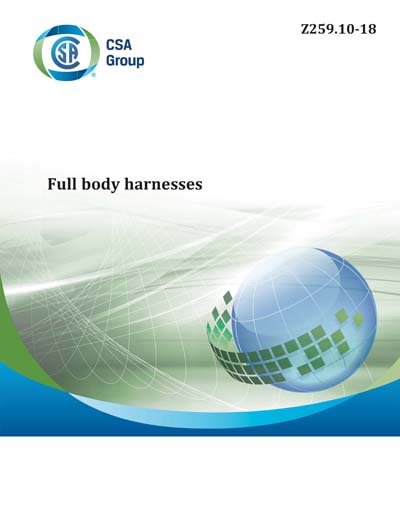Most recent
CSA Z259.10-2018
Full body harnesses
Preface This is the fourth edition of CSA Z259.10, Full body harnesses. It supersedes the previous editions published in 2012, 2006, and 1990. The purpose of this Standard is to specify requirements for the design, testing, performance, marking, and instructions for use of full body harnesses. Major changes to this edition include the following: a) the addition of a new Class of full body harnesses, Class R: Arc resistant; b) the addition of a new requirement to ensure all full body harnesses permanently incorporate a waist belt or back strap or other means of controlling the separation of the shoulder strap on the back of the full body harness (Clause 4.5); c) the addition of a new informative annex (Annex A) providing guidance on the sample requirements for full body harnesses; d) the dynamic drop test procedure for Classes A, D, E, L and P have been updated allowing for flexibility in free-fall height while maintaining the 16 kN (3600 lbf) maximum arrest force to allow for more rigid materials and constructions; and e) the references (Clause 2) and definitions (Clause 3) have been updated. Scope 1.1 General This Standard specifies requirements for the design, testing, performance, marking, and instructions for use of full body harnesses. Full body harnesses are intended for use as body supports in personal fall- arrest systems and in other work situations that involve the risk of falling. 1.2 Exclusions This Standard does not cover a) full body harnesses for use in recreational situations such as mountaineering; or b) full body harness accessories sold as attachments or aftermarket additional items for users such as tool holders, etc. 1.3 Stipulation of design This Standard does not stipulate designs for full body harnesses, except insofar as design limitations are necessary to ensure safe and durable service. 1.4 Tolerances Unless otherwise stated within this Standard, all units have an acceptable tolerance range of 2%. 1.5 Terminology In this Standard, "shall" is used to express a requirement, i.e., a provision that the user is obliged to satisfy in order to comply with the standard; "should" is used to express a recommendation or that which is advised but not required; and "may" is used to express an option or that which is permissible within the limits of the Standard. Notes accompanying clauses do not include requirements or alternative requirements; the purpose of a note accompanying a clause is to separate from the text explanatory or informative material. Notes to tables and figures are considered part of the table or figure and may be written as requirements. Annexes are designated normative (mandatory) or informative (non-mandatory) to define their application. 1.6 Units of measurement The values given in SI units are the units of record for the purposes of this Standard. The values given in parentheses are for information and comparison only.
CSA America, Inc. [csa]

